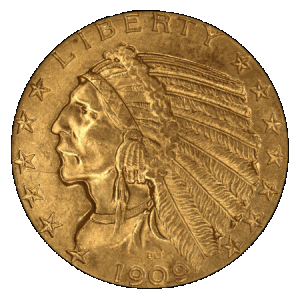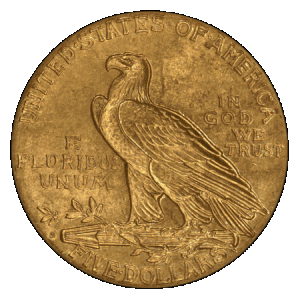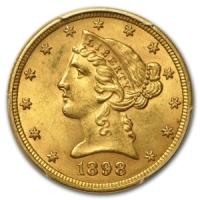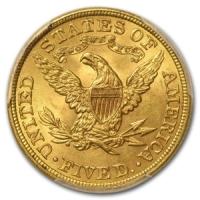Indian Half Eagles

 $5 Indian Gold Half Eagles - with incused design and without raised rim
$5 Indian Gold Half Eagles - with incused design and without raised rim
The $5 Indian Gold Half Eagles succeeded the $5 Liberty Gold Half Eagles in 1908. Despite their age, Indian Half Eagles aren't rare gold coins since about 14 million of them were produced by the US Mint with years of interruption between 1908 and 1929. The coins were minted at the US Mint facilities in Philadelphia, San Francisco, New Orleans and Denver. Proof mintage only occurred in Philadelphia in very small numbers just like with all the other pre-1933 U.S. gold coins.
The $5 Half Eagles were made of 90% gold and 10% copper with each coin containing 0.24187 oz of gold. The obverse side of the coins shows a Native American Indian Chief wearing a traditional headdress. An eagle standing on a bundle of arrows and an olive branch can be seen on the reverse. These images were also used on the $2.5 Indian Gold Quarter Eagles.
If you want to buy gold in the form of Indian Half Eagle coins, you should know that they possess two highly unusual features. First of all, the coins don't have a raised rim. Second, the design of both sides of the Indian Gold Half Eagles is incused below the surface. American buyers that are investing in gold for their retirement should take note that the coins are not eligible for inclusion in Individual Retirement Accounts (IRA's) since they are classified as collectible gold coins by the IRS.


Coin Fact Sheet
| Weight | Face Value | Purity | Diameter |
|---|---|---|---|
| 0.24187 oz | US $ 5 | 90% | 21.6 mm |
Total Mintage: 14,078,066
Indian Half Eagle Coin Design
Bela Lyon Pratt created the design of the Indian Head Half Eagle's obverse side. It depicts an incredibly detailed image of a Native American Indian Chief wearing a traditional headdress. The designer's initials "B.L.P." and the year of mintage is inscribed underneath the portrait. Along the outer periphery appears the word "LIBERTY" as well as 13 stars that are meant to represent the original states of the United States.
The reverse side of the Indian Head Half Eagles depicts an eagle standing on a bundle of arrows and an olive branch. "IN GOD WE TRUST" is inscribed to the right of the eagle and "E PLURIBUS UNUM" appears to the left of the eagle's breast. The coin's denomination ("FIVE DOLLARS") and "UNITED STATES OF AMERICA" is inscribed along the lower and upper edge of the coin. Indian Half Eagle gold coins that were minted in San Francisco (mint mark: S), New Orleans (mint mark: O) or Denver (mint mark: D) contain a mint mark next to the bundle of arrows. However, coins that were minted at the main Philadelphia branch of the United States Mint don't have any mint mark.
An unusual characteristic of the Indian Half Eagle coin is the fact that both of its sides have their design sunken below the surface. Furthermore, you won't find a raised rim on a $5 Indian Gold Half Eagle coin. That is very unusual for a coin issued by the US Mint.
History of the $5 Indian Gold Half Eagle
The Indian Gold Half Eagle was commissioned by the American President Theodore Roosevelt in the early 1900's. The design was created by the artist Bela Lyon Pratt (a student of Augustus Saint-Gaudens) and production started in 1908 when the coin replaced the earlier Liberty Head version of the $5 Half Eagle. Regular continuous production of the $5 Indian Gold Half Eagle ceased in 1916. After that, the coins were only produced in 1929. However, many of the coins minted that year were probably later melted down into bullion (due to currency laws passed during the Great Depression).
Rare Dates
Especially hard to find nowadays are the coins that were minted in New Orleans in 1909 (34,200 coins), Denver in 1911 (72,500 coins) and Philadelphia in 1929 (662,000 coins of which many have been melted down).
Proof specimens of the Indian Half Eagle gold coin were only minted in Philadelphia and are even rarer to find if at all possible. Proofs were only minted from 1908 to 1915 and mintage numbers varied from a minimum of 75 to a maximum of 250 coins.
Mintage Numbers
Annual mintage of the Indian Half Eagle at the various US Mint branches varied between 34,200 coins (New Orleans 1909) and 3,423,560 coins (Denver 1909). Proof coins were exclusively minted at the Philadelphia branch of the US Mint and proof mintage varied between 75 coins (1915) and 250 coins (1910).


Liberty Gold Half Eagles
The $5 Liberty Gold Half Eagles were the predecessors of the $5 Indian Gold Half Eagles. The US Mint produced them from 1839 to 1908. The coins were struck at the US Mint facilities in Philadelphia, New Orleans, San Francisco, Carson City, Charlotte, Dahlonega and Denver, making them the only US coins that were produced at 7 different mint facilities. Their composition is 90% gold and 10% copper with each coin containing 0.24187 oz of gold. Close to 61 million Liberty Half Eagles were minted. However, only a tiny amount were minted in proof condition at the Philadelphia facility. The obverse side of the coins depicts Lady Liberty in profile and an eagle holding a shield appears on the reverse.
The Liberty Gold Half Eagle page gives more information about the coins and allows you to compare current prices.